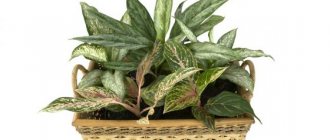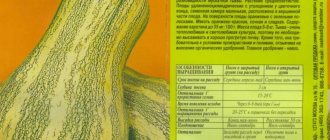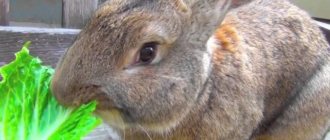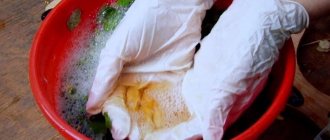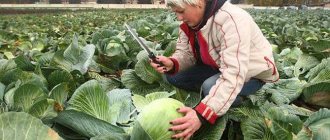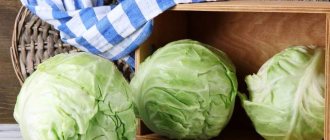What do black dots on cabbage mean and can it be eaten?
It often happens that the crop has already been grown and prepared for storage for the winter.
And you take out a head of cabbage, cut it, and there... A lot of black dots. The first question that arises is where did they come from and what to do with the harvest now.
Let's take a closer look at where these blackheads come from and how to prevent their appearance in the future.
Description of the fruit and vegetable crop
Chinese cabbage is a vegetable from the Brassica family, one of the subspecies of turnips. The crop is also called Chinese or lettuce, Chinese lettuce or petsai. When cultivated, it is grown as an annual plant.
The vegetable has the shape of a rosette in the form of a loosened head of cabbage. The shape of the vegetable is cylindrical. Cabbage foxtails are wavy, loose, and have jagged or wavy edges. The color of the product is most often light green. There are also yellow and bright green specimens. The product contains vitamins A, C, B1, B2, B6, PP, which are essential for the human body. The leaves also contain up to 3.5% protein.
Why do blackheads appear?
So, the main reason for the appearance of these unpleasant black dots on cabbage leaves is punctate necrosis. But other diseases - white rot, gray rot, vascular bacteriosis - can also cause an outwardly similar manifestation, subsequently changing.
Pests can also be the cause of their appearance. Sometimes easily removed black spots between cabbage leaves can be the excrement of cabbage or turnip white caterpillars living in them, which not only spoil the cabbage, leaving their waste products on it, but also eat the leaves and damage the heads of cabbage.
Let's take a closer look at plant diseases that cause the appearance of black spots.
- Spot necrosis is a disease characterized by the appearance of black spots on the inner leaves of white cabbage, which are up to three millimeters in size and may be slightly depressed. This disease appears when the heads of cabbage are fully formed, that is, before harvesting.
The reason for its appearance is the excessive application of nitrogen fertilizers. This causes a disruption in the maturation of leaf parenchyma tissues and leads to a kind of point necrosis. As a rule, such spots are subsequently affected by fungal infections, which is why their color may change over time.
During storage, the disease progresses and closer to spring, the leaves of cabbage heads are sometimes simply dotted with black dots. The disease is not initially infectious. It appears as a result of metabolic disorders due to biochemical changes occurring in vegetables.
- Vascular bacteriosis can also cause the appearance of dark spots on the leaves. It also attacks leaves, but these spots appear mainly on the petioles and veins.
- White rot. The lower leaves of cabbage, as well as the root collar, are mainly affected. As a result of the disease, the leaves become discolored in patches and become covered with mycelium.
By the beginning of harvesting, the mycelium becomes dense, and black spots of various shapes appear. The cause of this disease is also excess nitrogen in the soil and its increased acidity.
- Gray rot. Heads of cabbage become infected with it already during storage. Externally, it manifests itself in the partial covering of the cuttings of the lower leaves of the head of cabbage with grayish mold interspersed with small black dots.
Common diseases of Chinese cabbage
Pests are carriers of dangerous cabbage diseases. Harmful microorganisms penetrate into the damage left on the stems and leaves of garden crops by bugs, flea beetles, and caterpillars. They provoke the development of bacteriosis and rot, which are very difficult to get rid of.
Chinese cabbage is affected by the following diseases:
- Alternaria blight. It is manifested by the appearance of black spots on the leaf blades. Infected specimens gradually turn yellow, wither and then die.
- Downy mildew. Gray blurry spots with a fluffy coating form on the leaves. In cauliflower, the central head dies off, after which the plant dies.
- Mucous bacteriosis or wet rot. Dirty yellow wet spots appear on individual leaves. At the same time, the heads of cabbage smell unpleasant.
- Vascular bacteriosis is characterized by yellowing of cabbage leaves and blackening of their veins.
- Point necrosis also occurs due to infection in the soil or damage to the heads of cabbage. Black dots of different sizes appear on the leaves outside and inside the heads.
Prevention and treatment
Spot necrosis appears on cabbage leaves due to disturbances in plant nutrition during growth and ripening. This usually happens when there is too much nitrogen in the soil. Further, the development of this disease is facilitated by improper storage conditions.
To prevent the appearance of black spots on cabbage, the following conditions must be observed:
- Follow agricultural practices for cultivating crops and regulate the application of fertilizers. Preference should be given to phosphorus-potassium fertilizers, as well as those containing boron and molybdenum.
- It is also necessary to reduce soil acidity by liming or adding wood ash. These agrotechnical measures will reduce the possibility of spot necrosis on cabbage, prevent the appearance of white and gray rot, and vascular bacteriosis.
- To combat turnip or cabbage whites, you need to weed the plantings in time. When caterpillars appear, spray with a decoction of wormwood or celandine.
- Use necrosis-resistant varieties of white cabbage, such as Zimovka 1474, Amager 614, Slava 1305 and others.
- Harvesting should be carried out in dry weather. The heads of cabbage must be mature. Vegetables without visible signs of disease are stored for storage.
- Optimal storage conditions for the culture must be observed. The air in the storage room must be well ventilated. It is advisable to maintain the temperature within 0 – 1˚С, humidity 85 – 90%. Heads of cabbage during storage should be checked and if diseases of white or gray rot, as well as vascular bacteriosis, appear, remove the leaves and trim the stalk.
In conclusion, I would like to note that by strictly observing the agricultural technology of cultivating the crop and the storage conditions of the crop, the percentage of damage to cabbage heads will be significantly reduced.
Prevention of pest invasion of Chinese cabbage
It is much easier to prevent insect attacks on cabbage plantings than to fight them later, risking losing the harvest. What do we have to do:
- in the fall, remove all plant debris from the garden;
- Weed the beds in a timely manner;
- follow crop rotation recommendations;
- inspect cabbage leaves for pests;
- cover the plants with a special fine mesh that protects against the penetration of insects, slugs and snails;
- timely and correctly feed Chinese cabbage;
- use simple and affordable pest repellents - wood ash, hot ground pepper, mustard, soap solution to treat the crop.
Pest control of Chinese cabbage must begin immediately. Gardeners know that inaction will lead to the situation getting out of control, because insects multiply quickly and take over new plants. It is important to feed cabbage and carefully care for it, because healthy plants are more resistant to harmful attacks.
Why do they form on leaves?
Black dots are characteristic of 3 conditions at once. This may be a physiological disorder of the crop associated with improper growth conditions and excess nutrients in the soil. Dark specks are a symptom of some diseases , as well as a sign of pests “invading” Beijing.
- One of the main causes is a physiological disorder or punctate necrosis. Occurs due to metabolic disorders in cabbage. Reason for appearance:
- soil alkalization;
- excess nitrogen and phosphorus.
Affects mature heads of cabbage before harvesting. It also affects the heads during storage and progresses quickly - by spring, the leaves of the Pekin plant are literally dotted with small black dots.
- In second place in terms of frequency of occurrence is Alternaria . This is a fungal disease that develops in conditions of high humidity. It can affect cabbage at the seedling stage - dark stripes and spots appear on the leaves. On adult plants, in addition to black spots, a sooty coating forms on the leaves, which contains conidia of the fungus. The “incubator” for infection is plant debris and unharvested weeds. The pathogen is also carried by pests.
- Other probable causes of blackheads: Infestation with cabbage flea beetle. Initially, the dots have a transparent grayish tint, but over time they turn black.
- Infection with cabbage whites. Black dots between the leaves are traces of pest excrement.
- Vascular bacteriosis. Dark spots appear on the veins and petioles of leaves.
- White rot. The lower leaves and root collar are affected. Peking leaves become discolored over time and become covered with mycelium.
- Gray rot. Develops during storage. The lower leaves of the cabbage are partially covered with grayish mold and are interspersed with small black dots.
Pests affecting Chinese cabbage
Various types of insects love to feast on the delicate leaves of the pekinka plant. These include:
- cabbage flies;
- aphid;
- cruciferous flea beetles;
- thrips;
- cruciferous bugs;
- butterfly larvae - cutworms, white moths, cabbage moths;
- secretive proboscis;
- slugs, snails.
The last pests on the list belong to the genus of mollusks. They eat succulent leaves of plants. In order for the fight against these species to be successful, it is first worth getting to know each of them better.
Common aphid
Aphids are light green insects. The length of its body, covered with a waxy coating, does not exceed 2 mm. In spring and until mid-summer, wingless individuals are found in the garden. They reproduce without fertilization, producing live larvae. Towards the end of summer, winged individuals appear in the areas. They move freely from one plant to another.
Winged aphids lay eggs on the underside of leaf blades. Insects seriously harm cabbage and many other garden crops, as they feed on their juice. If no action is taken, aphid colonies quickly increase in size - each female produces up to 100 individuals. After 2 weeks they become sexually mature, and the cycle repeats.
It is easy to detect pests on cabbage - just inspect the covering leaves from the underside. Affected plants gradually weaken and wither. If an insect attack occurs at the beginning of the growing season, the cabbage does not set heads and growth slows down. If aphids settle in the garden bed at the end of summer or early autumn, the affected heads of cabbage become deformed and often begin to rot.
Aphids are a pest of cabbage
Cabbage fly
There are 2 types of cabbage flies. Spring ones fly out in late April, when dandelions bloom and lilacs bloom. The insects are gray in color and have 3 longitudinal stripes on their backs. The male's body length is 5 mm, the female's is 6 mm.
Summer flies are similar to their counterparts, except that they differ in larger sizes. This species appears in the beds in June. Pest activity increases at air temperatures above 18 degrees.
Cabbage flies lay eggs on the stems of plants from the Cruciferous family, including Chinese cabbage. The hatched larvae - white worms about 8 mm long - eat the roots of the crops. As a result, plant nutrition is disrupted, and the damaged underground part begins to rot.
Cruciferous flea beetle
In the spring in the garden you can see small jumping bugs no more than 3 mm long, settled on heads of cabbage - this is a flea beetle on Chinese cabbage. There are several types of pests:
The first three species have 2 yellow stripes on the back running along the body. The last flea beetle on the list stands out from its fellows by the presence of dark green or blue elytra.
Having awakened in the spring, insects eat plant debris and weeds, and later attack seedlings. Pests damage the tender leaves of young crops, including cotyledons. The larvae of the flea beetle also like to eat cabbage; they pierce the green parts of the plants, leaving holes in them. Young Chinese cabbage seedlings quickly die due to the attack of cruciferous flea beetles.
Cabbage pest cruciferous flea beetle
Cabbage moth, cutworm and white moth
Caterpillars on Chinese cabbage appear thanks to butterflies. These insects lay eggs on the leaves, and soon they hatch into caterpillars that feed on the above-ground parts of the plant.
- The cabbage moth looks like a moth with brown-gray inconspicuous wings framed by fringe. It does not harm Chinese cabbage because it feeds on flower nectar. Its larvae are dangerous - green caterpillars. Their length is 12–15 mm. In one growing season, the moth produces up to 6 generations of voracious larvae that can destroy the entire Chinese cabbage crop.
- The cutworm is a larger butterfly that hunts at night. Its front wings are red-brown, and its hind wings are gray. The first generation of insects appears in May, the second in July. Females lay eggs on the leaves of garden crops. A little later, caterpillars about 3 cm long appear from them. Their color can vary from light green to gray-brown. The voracious larvae eat leaves and gnaw deep tunnels in cabbage heads.
- The white butterfly is a large butterfly with white forewings with dark spots. The hind wings are colored light yellow on the underside. The cabbage plant produces up to 100 eggs per clutch. After 2 weeks, larvae emerge from them. Depending on their age, their appearance changes. The adult caterpillar is gray-green in color and has longitudinal yellow stripes and dark spots on its body. The larvae eat cabbage leaves, and when they grow up, they penetrate deep into the heads of cabbage, gnawing holes in them.
Attention! Another danger of caterpillars is that infection penetrates into the damage they leave on plants. As a result, Chinese cabbage diseases develop.
Cruciferous bug
Depending on the species, the color of cruciferous bugs may vary. The most common cabbage bugs in Russia are those with a red and black pattern on the back. Their head is equipped with five-segmented antennae.
In early spring, they feed on plant debris and humus, and then move to the beds with seedlings. Pests pierce the leaves and suck the juice. The secretion secreted by the bugs penetrates into the damaged areas, causing the plant cells to die.
Is it possible to eat this Chinese vegetable?
It is not recommended to eat the heads that have black “marks” on them. This is unpleasant to do for aesthetic reasons, although such cabbage does not pose any particular danger to the body.
Chinese cabbage with black dots is not suitable for industrial purposes. It is not recommended to put it on sale.
Gardeners who feel sorry for their work and effort are advised to thoroughly rinse the infected head, cut out all the dark spots with a knife and then use the cleaned head for food. The taste of Beijing is not lost.
How to treat Chinese cabbage against pests?
When growing crops from the Cruciferous family on a plot, gardeners often encounter various difficulties - the plants are attacked by crawling and flying insects. Pests of Chinese cabbage and the fight against them is one of the burning issues in which those who set themselves the task of harvesting a good harvest need to be competent. Summer residents need not only to learn to recognize enemies attacking cabbage beds, but also to properly carry out treatment and prevention.
If formed during cultivation
Farmers must make every effort to protect Beijing from disfiguring black spots. But, if such a problem has already happened, you need to know how to stop it in time.
What to do if they appear?
When an urgent solution and quick effect are required, chemicals are used. For Alternaria, bacteriosis and rot, the following drugs are used:
- Speed – 3.5-4 ml per bucket of water.
- Quadris – 40 ml per 10 liters of water.
- Abiga PIK – 50 g per 10 liters of water.
- Ordan – 1 sachet per 5 liters of water.
- Oxychom – 4 g (1 packet) per 2 liters of water.
- Profit Gold - 1.5 g per 3 liters of water.
- Khom - 40 g per 10 liters of water.
- Immunocytophyte – dissolve 2 tablets in 3 tbsp. water, add 1.5 liters of water to the resulting concentrate.
An excellent effect can be achieved using products based on copper and sulfur with a contact type of action. Kuprosil is excellent (see the exact dosage on the packaging).
Cabbage must be sprayed against pests with the following preparation:
- Iskra-M.
- Kemifos.
- Fury.
- Bankol.
- Intavir.
- Aktara (for instructions and quantities for Chinese cabbage, see the packaging).
After treating Chinese cabbage with any chemicals, you should not eat the vegetable for at least 14 days. It is best to carry out treatment against black spots for preventive purposes before the mass growth of heads of cabbage begins.
If the problem of black spots appeared before the harvest itself, you can try to save the situation using folk methods:
- Ammonia . For 10 liters of water 1 tbsp. soap and 2 tbsp. ammonia. Mix thoroughly and immediately spray the cabbage bed. Pay special attention to the lower leaf plate.
- Salt . Dissolve 250 g in a bucket of water, wait until the soda is completely dissolved. Pour the liquid into a watering can and pour the Peking over the heads.
- Vinegar . For 10 liters of water 1 tbsp. concentrate. Pour into a garden watering can and water one leaf at a time.
- Naphthalene, sand and ash . Mix the ingredients and scatter the resulting mixture on the garden bed.
- Copper sulfate . 5 g per bucket of water, additionally add 1-2 tbsp. grated tar soap. Pour fresh mixture over the cabbage.
How to prevent the appearance?
Preventing the problem from occurring - compliance with vegetation requirements and preventive standards:
- In autumn, deep plowing of the soil is necessary to destroy primary sources of infection.
- Mandatory adherence to planting sequences (crop rotation).
- Selection of varieties resistant to spot necrosis - Manoko F1, Bokal, Nezhnost F.
- Before planting, Chinese cabbage seeds are treated with Tiram (5 g per 1 kg of seeds) or the planting material is heated for 20 minutes.
- A reasonable approach to fertilizing. In the second half of the growing season, ash is added, and boron, phosphorus, and molybdenum are moderately added to the soil. Slaked lime is applied to acidic soils.
- Timely destruction and removal of weeds from beds.
- Weeding, regular preventive spraying.
Black spots on Chinese cabbage leaves are a common problem. Appear due to a physiological disorder or disease. Also, dark marks are traces of pest attack. The problem requires a quick solution and elimination, since heads with black dots are not recommended for consumption, nor are they recommended for sale.
If you find an error, please select a piece of text and press Ctrl+Enter.
Pest control methods for Chinese cabbage
Having discovered insects in cabbage beds, gardeners use different methods to combat them. It is advisable to use folk remedies for prevention or at the first signs of an attack. Chemical insecticides are resorted to if hordes of pests continue to increase and get out of control.
Folk remedies for pests of Chinese cabbage
Recipes used by our grandmothers will help you get rid of sucking and gnawing pests of Chinese cabbage:
- Garlic heads (10 pieces) are crushed and filled with 5 liters of water. After 4 hours, place the pan on low heat and cook the drug for 2-3 hours. The product is infused for a day under the lid, filtered and used to spray cabbage.
- Wood ash is scattered under plants and is also used to dust heads of cabbage.
- A piece of laundry or tar soap is grated, dissolved in 10 liters of water and sprayed onto plants affected by pests.
- Twigs of wormwood or laurel leaves are placed under each bush to repel insects.
Attention! Most pests lay eggs on the underside of leaf blades, where they are difficult to detect; this must be taken into account when processing Chinese cabbage.
Destroying slugs on a site is not an easy task, because they hunt at night. Experienced gardeners set traps to attract pests. To do this, objects are laid out in the garden - boards, stones, slate so that slugs can crawl under them. The ground under these structures is moistened. When it gets hot, the mollusks hide there. All that remains is to collect them.
Another way to combat slugs on Chinese cabbage is to pour a strip of coarse sand, sawdust or broken bricks around the beds. Slugs will not be able to get over such sharp barriers without getting hurt.
Chemical and biological drugs
Insecticides effectively combat various pests of Chinese cabbage, but their use is unsafe, especially at the final stage of cabbage formation. It is important to consider the waiting period, this is the time during which toxins are removed from the plant cells.
Processing of Chinese cabbage is carried out twice per season - after planting the seedlings in the ground and 2-3 weeks before the ovaries begin to appear. The beds are processed in dry, windless weather using protective equipment.
Biological products are created on the basis of living microorganisms:
They are absolutely safe for humans and pets, birds and beneficial insects. Most bioinsecticides affect the nervous system of pests, paralyzing them. Unable to feed, they soon die.
Popular biological products against pests of Chinese cabbage:
Biological products against pests of Chinese cabbage
- Aktofit;
- Bitoxibacillin;
- Verticillin;
- Antony.
Attention! Biological agents are compatible with each other and can be mixed. It is important to consider that they work more effectively when the thermometer is above +18 degrees.
Black spots on fish - you can eat it
Date of publication – 05/04/2013
Black spots on the body of fish are a disease called post-diplostomosis, or black-spot fish disease. It is caused by the larvae of the parasitic worm Postodiplostomum cuticola. The adult worm has a flat body 1.5 mm long and 0.5–0.09 mm wide. It parasitizes the intestines of fish-eating birds such as night herons and herons.
In the intestines of birds, worms produce eggs from which larvae emerge. The larvae enter the water and penetrate the body of the intermediate hosts - mollusks. In the mollusk, asexual reproduction of larvae occurs, as a result of which larvae are obtained again, but of a different structure - cercariae. So they are parasites on fish.
Where do blackheads come from? Cercariae enter the water and penetrate the skin of fish. At the same time, a connective tissue capsule is formed in the skin at a depth of 1.5–2 mm around the larva, in which black pigment is deposited - a product of the breakdown of blood cells and pigment cells of the skin of the fish. This is how blackheads appear.
Postodiplostomosis occurs everywhere, but it is most widespread in the south of Russia, Western Siberia and the Far East. The appearance of this disease in the Moscow region may be associated with the spread of mollusks that carry the disease or with the negative impact of pollution of water bodies.
Humans are neither the intermediate nor the definitive host of the parasite. While in the body of the fish, cercariae do not secrete toxins dangerous to humans. According to the relevant GOSTs, if commercial fish has single black spots on its body, it is allowed for sale without any special processing. So fish affected by post-diplostomosis can be eaten.
Of course, it must be properly prepared (cooked, fried, salted) to exclude the possibility of any other parasitic organisms remaining in it in a viable state.
Cause of black leaves
Most often, the cause of spoiled vegetables is vascular or so-called mucous bacteriosis. In this case, the veins of the cabbage leaf become black, resulting in a black mesh. The leaves may also wrinkle, dry out and become transparent. But there are a number of other factors that can lead to this problem. Let's look at them in more detail below.
Causes of blackness in a head of cabbage:
- unsuitable storage conditions for vegetables;
- damage by various diseases, such as gray rot, fusarium wilt, alterniosis.
If we are talking about improper storage of vegetables, then this can happen as a result of low access of oxygen, as well as the development of certain harmful microorganisms.
Gray rot causes an unpleasant moldy odor and a gray coating. It is important to remove all affected areas in a timely manner, otherwise damage to all products cannot be avoided. If the rotting leaves are removed in time and the head of cabbage is washed well, then the cabbage can be eaten.
Fusarium wilt can occur in vegetables that grew in dry weather. As a result, you can see darkened spots on the blood vessels. As a result, cabbage becomes completely unsuitable for food.
Alterniosis leads to very rapid rotting. They begin to easily separate from the head of cabbage.
How to treat the appearance of black spots
Treatment of plantings depends on the specific disease. Pointed necrosis is a symptom of improper plant nutrition. The disease cannot be cured. You can only prevent damage by properly applying fertilizing during the growing season.
Alternaria blight as a fungal disease is eliminated using fungicides. Among the most effective drugs for treating vegetables are Quadris, Skor and Immunocytophyte.
In order not to wonder about treatment methods, the vegetable grower needs to think about preventive measures in advance.
- These include:
- pre-planting digging of soil in the fall;
- replenishing the soil before planting with products containing elements of phosphorus, molybdenum and boron;
- planting varieties resistant to fungal infections;
- seed dressing with a 1% solution of potassium permanganate;
- planting vegetables after the “correct” predecessors, according to the rules of crop rotation;
- modern and regular watering, fertilizing, loosening the soil and weeding;
- storing the crop in a ventilated room at a temperature of +5. +7°C.
How to treat the appearance of black spots
The list of chemical-based drugs used to combat this disease includes:
The list of preventive measures to help fight blackheads contains the following recommendations:
- Follow the agrotechnical method of crop rotation;
- Removal of weeds;
- Try to protect plantings from insect pests;
- Carrying out deep plowing of the land in the fall;
- Seed material can be treated using the drug "Thiram";
- Providing hot heating for seeds (placing planting material to be processed in hot temperatures is the simplest folk method);
- Fertilizing plantings with potassium and ash;
- Adding the following substances to the soil: boron; molybdenum; phosphorus.
- Neutralization of acidified soils with lime;
- Dry the collected homemade seeds;
- Rejection of blackened seeds during harvest inspection;
- Providing the necessary storage conditions for heads of cabbage;
- Selection of varieties resistant to diseases.
When grown independently, a disease such as black spots on Chinese cabbage can be cured. When choosing this product at a grocery store, it is enough to refrain from purchasing it.


